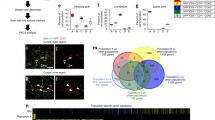Summary
The expression of glial fibrillary acidic protein (GFAP) in continuous glioma and non-glioma cell lines was evaluated by molecular hybridization and immunocytochemistry. RNA transcripts from the GFAP gene were detected in two of six cell lines by Northern blot analysis of cellular RNAs using a cloned mouse GFAP cDNA probe. The probe recognized a single GFAP RNA species of 2.7 kilobases under high-stringency washing conditions. The presence of GFAP transcripts as determined by molecular hybridization corresponded to the immunocytochemical detection of GFAP using two different monoclonal antibodies to this protein. These data indicate that GFAP expression in human cells can be detected by molecular hybridization using a murine GFAP cDNA probe, illustrating the high degree of interspecies conservation of GFAP. Molecular hybridization represents a reliable and sensitive method for the detection of GFAP expression in vitro, which can be used in conjunction with or as an alternative to immunocytochemistry.
Similar content being viewed by others
References
Arnstein P, Taylor DON, Nelson-Rees WA, Huebner RJ, Lennette EH (1974) Propagation of human tumors in antithymocyte serum-treated mice. J Natl Cancer Inst 52:71–81
Bigner DD, Bigner SH, Ponten J, Westermark B, Mahaley MS, Ruoslahti E, Herschman H, Eng LF, Wikstrand CJ (1981) Heterogeneity of genotypic and phenotypic characteristics of fifteen permanent cell lines derived from human gliomas. J Neuropathol Exp Neurol 40:201–229
Collins VP (1983) Cultured human glial and glioma cells. Int Rev Exp Pathol 24:135–202
Chirgwin JM, Przybyla AE, MacDonald RJ, Rutter WJ (1979) Isolation of biologically active ribonucleic acid from sources enriched in ribonuclease. Biochemistry 18:5294–5299
Debus E, Weber K, Osborn M (1983) Monoclonal antibodies specific for glial fibrillary acidic (GFA) protein and fox each of the neurofilament triplet polypeptides. Differentiation 25:193–203
Denhardt DT (1966) A membrane-filter technique for the detection of complementary DNA. Biochem Biophys Res Commun 23:641–646
Eng LF (1985) Glial fibrillary acidic protein (GFAP): the major protein of glial intermediate filaments in differentiated astrocytes. J Neuroimmunol 8:203–214
Holt JT, Gopal V, Moulton AD, Nienhuis AW (1986) Inducible production ofc-fos anti-sense RNA inhibits 3T3 cell proliferation. Proc Natl Acad Sci USA 83:4794–4798
Izant JG, Weintraub H (1985) Constitutive and conditional suppression of exogenous and endogenous genes by antisense RNA. Science 229:346–352
Lewis SA, Balcarek JM, Krek V, Shelanski M, Cowan NJ (1984) Sequence of a cDNA clone encoding mouse glial fibrillary acidic protein. Structural conservation of intermediate filaments. Proc Natl Acad Sci USA 81:2743–2746
Maniatis T, Fritsch EF, Sambrook J (1982) Molecular cloning: a laboratory manual. Cold Spring Harbor Laboratory, Cold Spring Harbor, pp 188–189
McAllister RM, Isaacs H, Rongey R, Peer M, Au W, Soukup SW, Gardner MB (1977) Establishment of a human medulloblastoma cell line. Int J Cancer 20:206–212
Osborn M, Ludwig-Festl M, Weber K, Bignami A, Dahl D, Bayreuther K (1981) Expression of glial and vimentin type intermediate filaments in cultures derived from human glial material. Differentiation 19:161–167
Owens RB, Smith HS, Nelson-Rees WA, Springer EL (1976) Epithelial cell cultures from normal and cancerous human tissues. J Natl Cancer Inst 56:843–849
Paetau A, Virtanen I, Stenman S, Kurki P, Linder E, Vaheri A, Westermark B, Dahl D, Haltia M (1979) Glial fibrillary acidic protein and intermediate filaments in human glioma cells. Acta Neuropathol (Berl) 47:71–74
Pegram CN, Eng LF, Wikstrand CJ, McComb RD, Lee Y-L, Bigner DD (1985) Monoclonal antibodies reactive with epitopes restricted to glial fibrillary acidic proteins of several species. Neurochem Pathol 3:119–138
Ponten J, Westermark B (1978) Properties of human malignant glioma cells in vitro. Med Biol 56:184–193
Spengler BA, Biedler JL, Helson L, Freedman LS (1973) Morphology and growth, tumorigenicity, and cytogenetics of human neuroblastoma cells established in vitro. In Vitro 8:410 [abstr]
Westermark B, Ponten J, Hugosson R (1973) Determinants for the establishment of permanent tissue culture lines from human gliomas. Acta Pathol Microbiol Immunol Scand [A] 81:791–805
Yen SH, Fields KL (1981) Antibodies to neurofilaments, glial filaments and fibroblast intermediate filament proteins bind to different cell types of the nervous system. J Cell Biol 88:115–126
Author information
Authors and Affiliations
Additional information
Supported in part by a grant CA 37465 from the National Cancer Institute and AIDS Medical Foundation
Rights and permissions
About this article
Cite this article
Dewhurst, S., Stevenson, M., McComb, R.D. et al. Expression of glial fibrillary acidic protein in human glioma cell lines as detected by molecular hybridization. Acta Neuropathol 73, 383–386 (1987). https://doi.org/10.1007/BF00688264
Received:
Accepted:
Issue Date:
DOI: https://doi.org/10.1007/BF00688264



